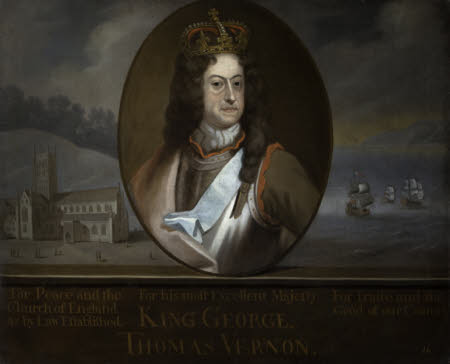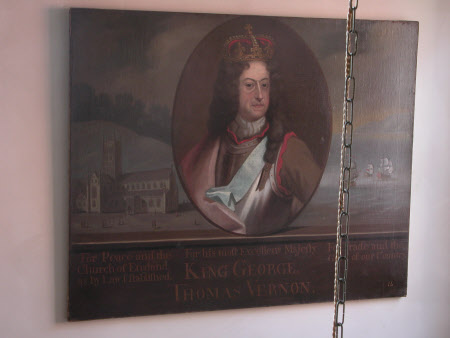King George I (1660–1727)
British (English) School
Category
Art / Oil paintings
Date
1715
Materials
Oil on canvas
Measurements
1016 x 1270 mm (40 x 50 in)
Place of origin
England
Order this imageCollection
Hanbury Hall, Worcestershire
NT 414252
Summary
Oil painting on canvas, King George I (1660–1727), British (English) School, 1715. A oval head-and-shoulders portrait of George I wearing a crown, with Worcester Cathedral to the left and shipping to the right. Painted on a simulated parapet across the lower portion of the picture is: left: For Peace and the / Church of England / as by Law Established. Centre: For his most Excellent Majesty / KING GEORGE. / THOMAS VERNON. Right: For Trade and the / Good of our Country. Bottom right corner, in white: 14. A similar emblematic election sign painting of George I for Thomas Wylde, Worcester is in the Government Art Collection (GAC 8308).
Full description
The painting was presumably commissioned by Vernon as a kind of political manifesto painted before the 1715 election. The imagery encapsulates the political issues that brought George from Hanover to England, where he was crowned in October 1714. This campaign was planned and supported by members of the Whig party, who were determined to ensure a Protestant succession and the preservation of the Church of England after the death of Queen Anne. George I rewarded them with high office and patronage throughout his reign. The 1713 Treaty of Utrecht had ended twelve years of war with France, and the Whigs hoped for continued peace to enable the expansion of trade. Although there were mixed feelings in England about the treaty and the concessions that it gave to Louis XIV, there was peace throughout George’s reign, and Britain witnessed a massive expansion of trade and growth in national wealth during the years of the Hanoverian dynasty. Peace, Protestantism, King, trade and patriotism made up the ingredients of Vernon’s Whig manifesto, as illustrated by the portrait, cathedral and ships in the image. In the Hanbury portrait, George I wears a cuirass and mantle, the attire of a soldier. The blue ribbon of the Order of the Garter crossing his left shoulder was bestowed on him by Queen Anne in 1701 at the time of the Act of Settlement, and was always present in subsequent portraits. The image is similar to earlier portraits of George as Prince of Brunswick and Elector of Hanover; these show him as a military man involved in campaigns as an ally of the English against the French. (John Kerslake, Early Georgian Portraits, NPG London, 1997, p.88.) The immediate source for this painting was most likely a print made in 1714 by Bernard Picart (1673-1733), after an unknown painter, with an inscription celebrating George I as King (NPG D3284). It was probably copied from a Hanoverian painting of George I as Elector made before his royal portraits by Kneller. This is identical to the image of George I that appears in the Hanbury painting, except that in the print he is without a crown. It is a highly skilled line engraving that could have been printed by the thousand at the time of the coronation. The engraved frame surrounding the portrait celebrates George I in Latin as King of Great Britain and Ireland, Defender of the Faith, Duke of Brunswick-Lüneburg and Elector (of the Holy Roman Empire). The oval portrait surmounts the coronation regalia, the royal coat of arms and the Hanoverian electoral bonnet. The Thomas Wylde painting has no crown and is therefore closer to the original image. In both, however, the shape of the King’s face is made to conform more closely with the normal English portrayal of the King with jowls and a double chin. It is highly unusual for a British sovereign to be shown wearing a crown, and it creates a somewhat burlesque effect. The motive was probably to make it crystal clear that this Hanoverian intruder was the rightful king. The portrait was originally published by Picart himself, and then by Louis Renard, who changed the surrounding frame by the addition of oak leaves and a different inscription (NPG D32843). Picart was a major French draughtsman and engraver-printseller, who settled in Amsterdam for good in 1711. He was an important supplier of prints to the English market. He may have collaborated with Renard over the printing of the image in Amsterdam, or leased or sold him the plate. In 1717 Vandergucht copied the Picart portrait and surrounded it with a circle of finely etched ships representing the entire navy. The image was the frontispiece of a report presenting a plan and costings for its improvement. (William Sutherland, Britain’s Glory: or Ship-Building Unvailed, London, 1717.) A copy of the 1729 edition was sold at Christie’s on 9th July 2002, lot 296. An election picture, evidently painted by the same artist, and for the same election, as an almost identical painting – save that in that the King wears no crown, and the words ‘For Peace and’ before ‘the Church of England’ are omitted – for a different candidate, that was acquired by the Government Art Collection from Appleby Bros. in 1969 (GAC 8308; see Oil Paintings in Public Ownership in the Government Art Collection, The Public Catalogue Foundation, 2007, p.41). The election must have been the first Hanoverian one, of 1715, since that was the only one to be fought by Thomas Vernon. He was returned, as a Whig, for Worcesterhire, along with one of the former Tory members, Sir John Pakington, but died before that of 1722, in February 1721, when his place was taken by Sir Thomas Lyttelton, in the Government interest. The inclusion of the words ‘For Peace’ in this, his manifesto, is significant, since he was to become a member of the secret committee set up by the House of Commons to inquire into the negotiations for the Peace of Utrecht that had recently ended the War of the Spanish Succession, under Queen Anne. He was always to vote with the Government, save on the Peerage Bill in 1719 (a measure intended to protect the Earl of Sunderland, should the Prince of Wales succeed his father and set about creating enough peers to outvote Sunderland’s supporters in the House of Lords). The painting in the Government Art Collection must also have been painted in 1715, and in Worcestershire, but it is on behalf of Thomas Wylde (?1670–1740), a Whig, one of the two members – the other being Samuel Swift, a Tory – who had sat, not for the county, but for the city, or independent borough, of Worcester, in the previous Parliament, the last of the reign of Queen Anne, and who were both returned for this one, the first of the reign of George I. The slogan ‘For Trade’ was even more appropriate for him than for Vernon, since he came from a family of clothiers, but later of lawyers, who had acquired The Commandery in Worcester, and his candidature was endorsed by the Levant Company, which laid particular emphasis on his encouragement of the English woollen industry, and on “the strenuous opposition that he made to that pernicious bill of commerce” – a commercial treaty with France that was associated with the Peace of Utrecht in 1713.
Provenance
Bequeathed by Sir Bowater George Hamilton Vernon, 2nd Bt (1865 - 1940)
Credit line
Hanbury Hall, The Vernon Collection (National Trust)
Marks and inscriptions
Thomas Vernon No 14 (inscribed)
Makers and roles
British (English) School, artist


